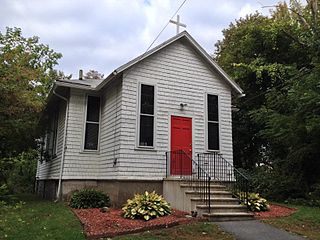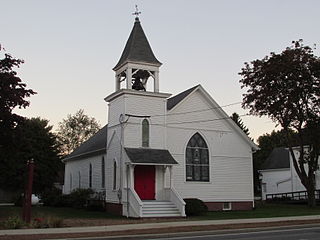The African Union First Colored Methodist Protestant Church and Connection, usually called "the A.U.M.P. Church", is a Methodist denomination. It was chartered by Peter Spencer (1782–1843) in Wilmington, Delaware, in 1813 as the "Union Church of Africans", where it became known as the "African Union Church".

St. Ann's Episcopal Church is an historic Episcopal church located on Church Street in Richford, Vermont, in the United States. Built in 1883, it is an architecturally a distinctive blend of Queen Anne and Gothic Revival architecture. On March 12, 2001, it was added to the National Register of Historic Places. The church is a defunct mission of the Episcopal Diocese of Vermont; no services are held there.

The Bethel African Methodist Episcopal Church and Parsonage is an historic church and parsonage at 6 Sever Street in Plymouth, Massachusetts. The congregation, founded in 1866, is one of a small number of African Methodist Episcopal (AME) congregations in eastern Massachusetts, and is an enduring component of the small African-American community in Plymouth. Its church, built about 1840 as a commercial building and consecrated in 1870, was listed on the National Register of Historic Places in 2007.

The Goodwin Memorial African Methodist Episcopal Zion Church is a historic church on Woodside Avenue in Amherst, Massachusetts. It is a member of the National African Methodist Episcopal Zion Church denomination, which is historically African American and began in the United States. The history of the Goodwin Memorial African Methodist Episcopal (A.M.E.) Zion Church in Amherst, Massachusetts is an important part of the broader context of African American history. The A.M.E. Zion denomination was created in conjunction with growing African American identities. Locally, the Goodwin Memorial A.M.E. Zion Church is one of the few physical structures that speaks to the rich African American history and heritage in the town of Amherst and surrounding areas.

Sherrill United Methodist Church is a historic church at 301 Main Street in Sherrill, Arkansas. Its congregation is one of the oldest and continuously active churches in Jefferson County, Arkansas. Established in 1847, it was originally called Sherrill Methodist Episcopal Church South. In 2002, under that name, its building, a fine Gothic Revival structure built in 1910, listed on the National Register of Historic Places.

St. Andrew's Episcopal Church is an active Episcopal parish and historic church building in Tampa, Florida, United States. The structure is located downtown at 505 North Marion Street, however, the parish offices are located at 509 East Twiggs Street. On April 15, 2009, the church building was added to the U.S. National Register of Historic Places (NRHP). Francis J. Kennard and Michael J. Miller are credited as the building's architects.

The Methodist Episcopal Church is a historic church and parsonage at 61 East Putnam Avenue in Greenwich, Connecticut. Built in 1868-69 for a Methodist congregation established in 1805, the church is a fine local example of Carpenter Gothic architecture, and the parsonage, built in 1872, is a good example of Italianate architecture. The property was listed on the National Register of Historic Places in 1988. The congregation is affiliated with the United Methodist Church.

The West Scarborough United Methodist Church, also known as the Dunstan Methodist Episcopal Church, is a historic church on U.S. Route 1 in Scarborough, Maine. The church building, built in 1839 and extensively altered in 1907, is one of the few surviving works of Maine architect and artist Harry Hayman Cochrane. The building was listed on the National Register of Historic Places in 1989 for its architectural significance.

The Methodist Episcopal Church of Winooski, also known as the Winooski United Methodist Church, is a historic Methodist church building located at 24 West Allen Street in Winooski, Vermont. It was built in 1918, and is a significant local example of vernacular Carpenter Gothic architecture. On March 2, 2001, it was added to the National Register of Historic Places.

The United Church of Ludlow, formerly the Congregational Church of Ludlow, is a historic church at 48 Pleasant Street in the village of Ludlow in Vermont. Built in 1891, it is one of the only churches in the state built in a fully mature expression of Shingle Style architecture. Its Congregationalist congregation was organized in 1806, and in 1930 it merged with a Methodist congregation to form a union congregation. The church was listed on the National Register of Historic Places in 2004.

The Mechanicsburg Baptist Church is a historic church in the village of Mechanicsburg, Ohio, United States. Constructed for a Methodist congregation in the late nineteenth century, the building was taken over by Baptists after the original occupants vacated it, and it has been named a historic site.

St. Paul's African Methodist Episcopal Church is a historic church in Urbana, Ohio, United States. Built in the Greek Revival style in 1876, it is home to a congregation that was founded in the mid-1820s.

Mechanicsburg United Methodist Church is a historic Methodist congregation in the village of Mechanicsburg, Ohio, United States. Founded in the early nineteenth century, it is the oldest church in the village, and as such it has played a part in the histories of other Mechanicsburg churches. Its fifth and present church, a Gothic Revival-style structure erected in the 1890s, has been named a historic site.

Mt. Zion Christian Methodist Episcopal Church, formerly Mt. Zion Colored Methodist Episcopal Church, is a historic African-American church in Union City, Tennessee, at the corner of North Greenwood and East College Streets.

The First Presbyterian Church of Tulsa was organized in 1885 in Creek Nation, Indian Territory, before statehood. It originally met in the store owned by brothers James M. Hall and Harry C. Hall, and was served by itinerant, circuit-riding ministers.

Imboden Methodist Episcopal Church, South, now the Imboden United Methodist Church, is a historic church at 113 Main Street in Imboden, Arkansas. It is a two-story brick building with Classical Revival styling. Designed by the Reverend James Glover, a former building contractor, it was built in 1922 for a congregation established in 1884, and is the city's finest example of Classical Revival architecture. It has a roughly cruciform plan, with a front porch supported by square posts, and topped by a parapet similar to that ringing the main roof.

The Goddard United Methodist Church formerly the Dodson Avenue Methodist Episcopal Church, is a historic church at 1922 Dodson Avenue in Fort Smith, Arkansas. The church building is an imposing Late Gothic stone structure, built in 1930 to a design by the local architectural firm of Haralson and Nelson. The congregation for which it was built was founded in 1908, and worshipped in a wood-frame church at this site prior to the construction of the present edifice. In October 1945 the church was renamed the Goddard Memorial Methodist Church in honor of a recent pastor, Dr. O. E. Goddard. The church complex includes, in addition to the church, a children's building, fellowship hall, and office building.

Trinity United Methodist Church is a historic Methodist church in Athens, McMinn County, Tennessee.

Trinity-St. James United Methodist Church is located in Cedar Rapids, Iowa, United States. The congregation began as a Sunday school in the northwest part of the city organized by Trinity Methodist Episcopal Church. The evangelist Billy Sunday had preached a revival there and over 300 people joined the church. St. James Methodist Episcopal Church, as it was then known, was established shortly afterward in February 1910. The congregation originally used the closed Danish Lutheran Church at K Avenue NW and Fourth Street NW for their services, and they moved the building that summer to Ellis Boulevard NW. St. James grew to the point that a new building was needed. In 1945 property across the street was purchased, and local architect William J. Brown designed the new church facility. Construction began in September 1952 and it was completed in April 1954 for $165,000.

First Methodist Episcopal Church, also known as United Methodist Church, is a historic church at 116 East Washington Avenue in Washington, Warren County, New Jersey. It was built from 1895 to 1898 with a Richardsonian Romanesque architectural style. The church was added to the National Register of Historic Places for its significance in architecture on July 17, 2017. The parsonage, built 1892, is also included in the listing.





















